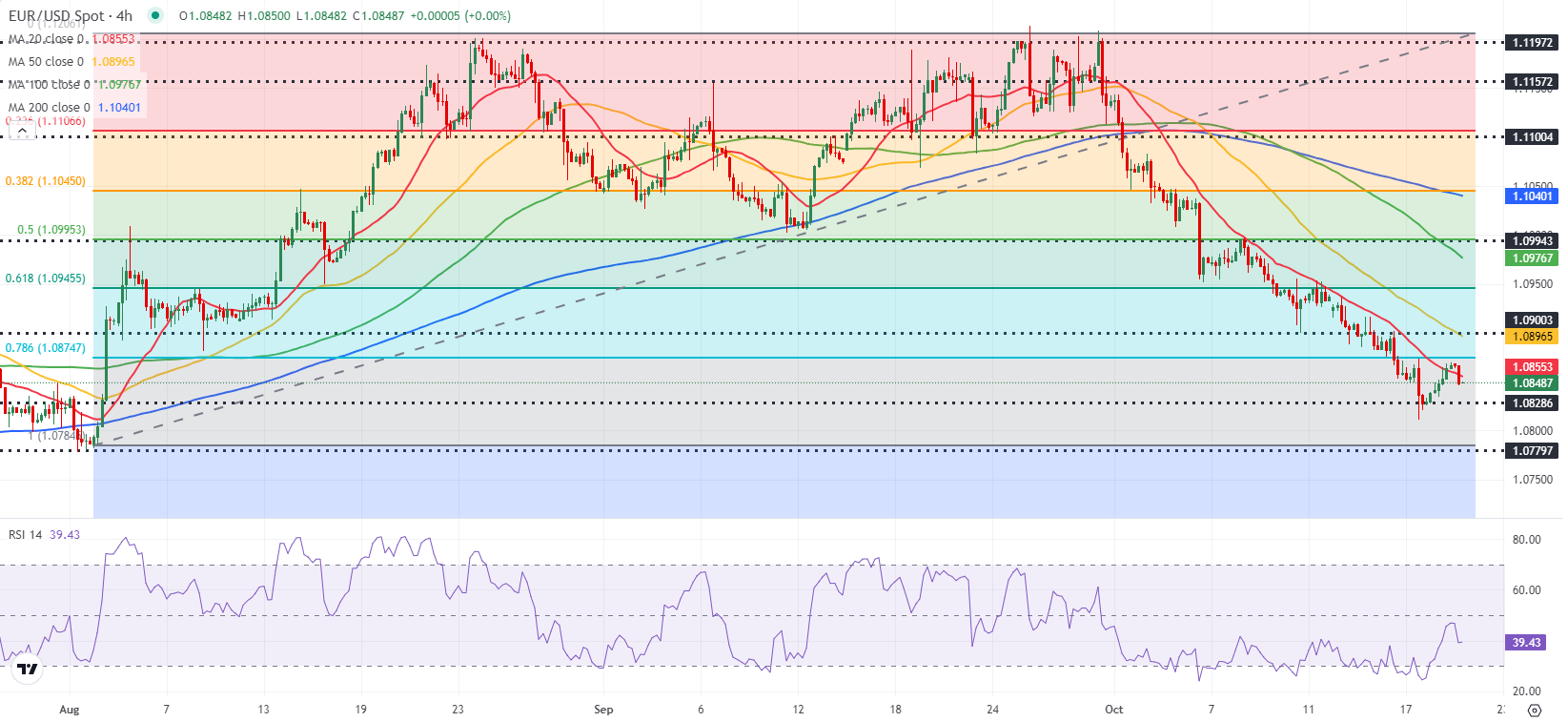- EUR/USD struggles to build on Friday's recovery gains.
- The technical outlook points to a bearish stance in the near term.
- Dovish comments from ECB officials don't allow the Euro to gain traction.
EUR/USD trades on the back foot to start the week and stays in negative territory at around 1.0850 after closing in the green on Friday. The pair's near-term technical outlook suggests that buyers remain reluctant to bet on an extended rebound.
Euro PRICE Last 7 days
The table below shows the percentage change of Euro (EUR) against listed major currencies last 7 days. Euro was the weakest against the US Dollar.
| USD | EUR | GBP | JPY | CAD | AUD | NZD | CHF | |
|---|---|---|---|---|---|---|---|---|
| USD | 0.79% | 0.34% | 0.49% | 0.33% | 0.88% | 0.71% | 0.97% | |
| EUR | -0.79% | -0.52% | -0.39% | -0.37% | 0.12% | -0.17% | 0.08% | |
| GBP | -0.34% | 0.52% | 0.12% | 0.02% | 0.68% | 0.38% | 0.58% | |
| JPY | -0.49% | 0.39% | -0.12% | -0.15% | 0.41% | 0.28% | 0.47% | |
| CAD | -0.33% | 0.37% | -0.02% | 0.15% | 0.49% | 0.40% | 0.46% | |
| AUD | -0.88% | -0.12% | -0.68% | -0.41% | -0.49% | -0.16% | 0.05% | |
| NZD | -0.71% | 0.17% | -0.38% | -0.28% | -0.40% | 0.16% | 0.19% | |
| CHF | -0.97% | -0.08% | -0.58% | -0.47% | -0.46% | -0.05% | -0.19% |
The heat map shows percentage changes of major currencies against each other. The base currency is picked from the left column, while the quote currency is picked from the top row. For example, if you pick the Euro from the left column and move along the horizontal line to the US Dollar, the percentage change displayed in the box will represent EUR (base)/USD (quote).
The improving risk mood heading into the weekend made it difficult for the US Dollar (USD) to preserve its strength and paved the way for a rebound in EUR/USD on Friday.
In the absence of high-tier data releases, dovish comments from European Central Bank (ECB) officials weigh on the Euro, causing EUR/USD to stretch lower on Monday.
ECB Governing Council member Gediminas Šimkus said on Monday that if disinflation gets entrenched, rates could get lower than the natural level. Meanwhile, ECB policymaker Martins Kazaks argued that interest rates are still inhibiting growth, adding that he expects rates to continue to decline as inflation falls further.
Later in the week, ECB President Christine Lagarde will be delivering speeches at different events. On Thursday, S&P Global will release preliminary October Manufacturing and Services Purchasing Managers Index (PMI) data for Germany, the Euro area and the US.
EUR/USD Technical Analysis
The Relative Strength Index (RSI) indicator on the 4-hour chart declines toward 40 after rising to the 50 area on Friday, suggesting that EUR/USD's remains bearish in the near term following a technical correction.
On the downside, 1.0830 (static level) aligns as interim support before 1.0780 (beginning point of the latest uptrend) and 1.0740 (static level from April). Looking north, immediate resistance could be spotted at 1.0870 (Fibonacci 78.6% retracement of the latest uptrend) ahead of 1.0900 (static level, round level, 50-period Simple Moving Average). A daily close above the latter could attract technical buyers and open the door for another leg higher toward 1.0950 (Fibonacci 61.8% retracement).
Euro FAQs
The Euro is the currency for the 19 European Union countries that belong to the Eurozone. It is the second most heavily traded currency in the world behind the US Dollar. In 2022, it accounted for 31% of all foreign exchange transactions, with an average daily turnover of over $2.2 trillion a day. EUR/USD is the most heavily traded currency pair in the world, accounting for an estimated 30% off all transactions, followed by EUR/JPY (4%), EUR/GBP (3%) and EUR/AUD (2%).
The European Central Bank (ECB) in Frankfurt, Germany, is the reserve bank for the Eurozone. The ECB sets interest rates and manages monetary policy. The ECB’s primary mandate is to maintain price stability, which means either controlling inflation or stimulating growth. Its primary tool is the raising or lowering of interest rates. Relatively high interest rates – or the expectation of higher rates – will usually benefit the Euro and vice versa. The ECB Governing Council makes monetary policy decisions at meetings held eight times a year. Decisions are made by heads of the Eurozone national banks and six permanent members, including the President of the ECB, Christine Lagarde.
Eurozone inflation data, measured by the Harmonized Index of Consumer Prices (HICP), is an important econometric for the Euro. If inflation rises more than expected, especially if above the ECB’s 2% target, it obliges the ECB to raise interest rates to bring it back under control. Relatively high interest rates compared to its counterparts will usually benefit the Euro, as it makes the region more attractive as a place for global investors to park their money.
Data releases gauge the health of the economy and can impact on the Euro. Indicators such as GDP, Manufacturing and Services PMIs, employment, and consumer sentiment surveys can all influence the direction of the single currency. A strong economy is good for the Euro. Not only does it attract more foreign investment but it may encourage the ECB to put up interest rates, which will directly strengthen the Euro. Otherwise, if economic data is weak, the Euro is likely to fall. Economic data for the four largest economies in the euro area (Germany, France, Italy and Spain) are especially significant, as they account for 75% of the Eurozone’s economy.
Another significant data release for the Euro is the Trade Balance. This indicator measures the difference between what a country earns from its exports and what it spends on imports over a given period. If a country produces highly sought after exports then its currency will gain in value purely from the extra demand created from foreign buyers seeking to purchase these goods. Therefore, a positive net Trade Balance strengthens a currency and vice versa for a negative balance.
Information on these pages contains forward-looking statements that involve risks and uncertainties. Markets and instruments profiled on this page are for informational purposes only and should not in any way come across as a recommendation to buy or sell in these assets. You should do your own thorough research before making any investment decisions. FXStreet does not in any way guarantee that this information is free from mistakes, errors, or material misstatements. It also does not guarantee that this information is of a timely nature. Investing in Open Markets involves a great deal of risk, including the loss of all or a portion of your investment, as well as emotional distress. All risks, losses and costs associated with investing, including total loss of principal, are your responsibility. The views and opinions expressed in this article are those of the authors and do not necessarily reflect the official policy or position of FXStreet nor its advertisers. The author will not be held responsible for information that is found at the end of links posted on this page.
If not otherwise explicitly mentioned in the body of the article, at the time of writing, the author has no position in any stock mentioned in this article and no business relationship with any company mentioned. The author has not received compensation for writing this article, other than from FXStreet.
FXStreet and the author do not provide personalized recommendations. The author makes no representations as to the accuracy, completeness, or suitability of this information. FXStreet and the author will not be liable for any errors, omissions or any losses, injuries or damages arising from this information and its display or use. Errors and omissions excepted.
The author and FXStreet are not registered investment advisors and nothing in this article is intended to be investment advice.
Recommended Content
Editors’ Picks

EUR/USD drops toward 1.0850 as USD finds fresh buyers
EUR/USD inches lower to near 1.0850 in the European session on Monday. A renewed US Dollar uptick amid a slightly negative shift in risk sentiment and Trump trade optimism weigh on the pair. All eyes remain on the Fedspeak, in the absence of top-tier data releases.

GBP/USD falls below 1.3050 on resurgent US Dollar demand
GBP/USD falls back below 1.3050 in European trading on Monday, undermined by a modest USD strength. The fundamental backdrop supports prospects for a further depreciating mov, as markets remain risk-averse ahead of the upcoming Fedspeak.

Gold rallies as safe-haven demand increases on intensifying Middle East conflict
Gold rises on increased safe-haven demand as the conflict in the Middle East deepens. Israel steps up bombing of Beirut and is poised to launch a retaliatory attack on Iran after a bomb explodes near Netanyahu’s house.

Three fundamentals for the week: Middle East escalation, BoC decision and US Jobless Claims stand out Premium
An Israeli attack against Iran may stir markets ahead of the US elections. The Bank of Canada is set to slash rates, impacting Fed expectations. US Jobless Claims remain a bellwether for the wider economy.

If at first you don’t succeed, keep trying, so the story goes in China
Asian stocks saw a solid lift today, riding the coattails of Wall Street’s rally, but a welcome spark came from China’s big banks slashing their benchmark lending rates. This move injected a fresh wave of optimism into markets, fueling the hope that China’s recent stimulus efforts might finally be gaining economic traction.

Best Forex Brokers with Low Spreads
VERIFIED Low spreads are crucial for reducing trading costs. Explore top Forex brokers offering competitive spreads and high leverage. Compare options for EUR/USD, GBP/USD, USD/JPY, and Gold.
